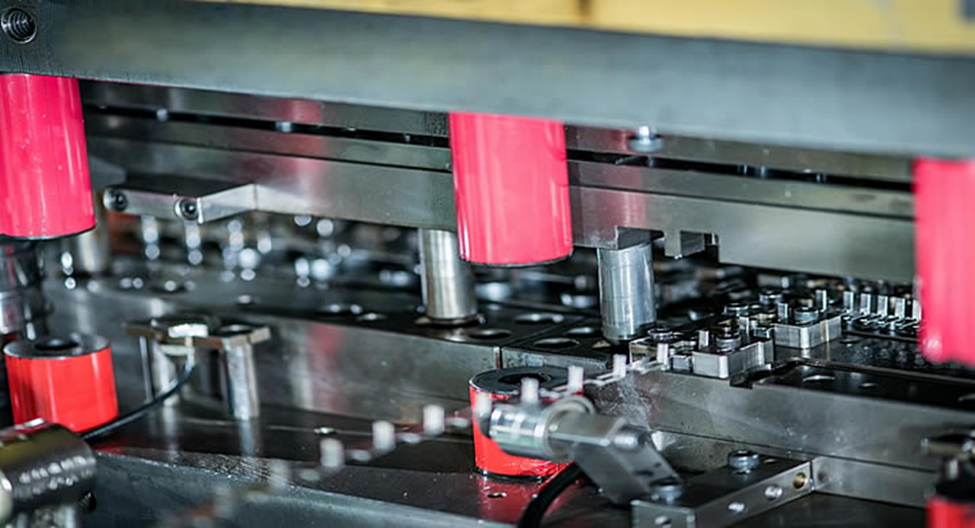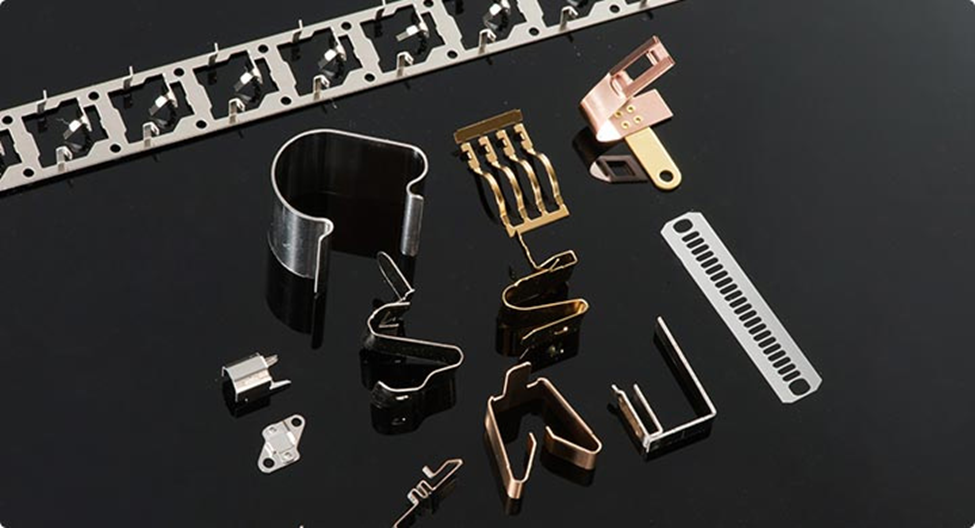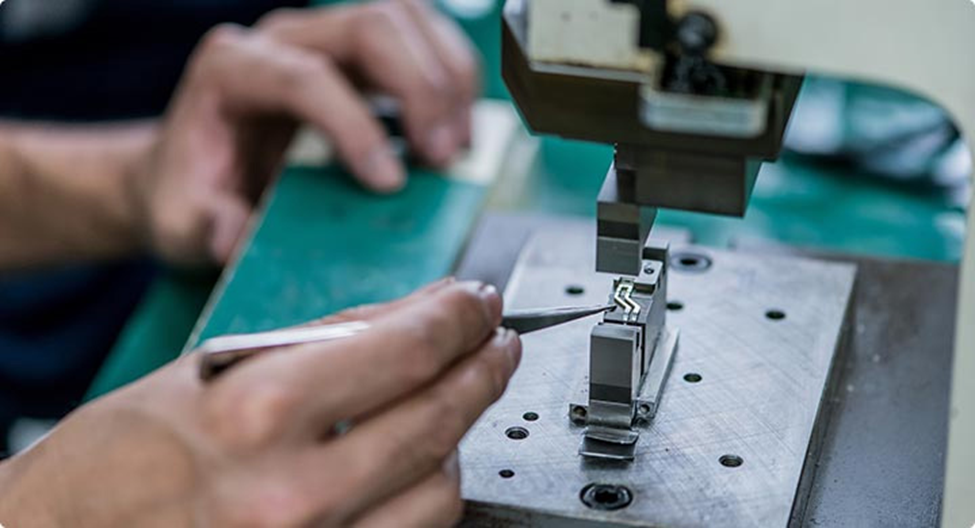
Mailbox:
info@hskcoltd.com
Mailbox:
info@hskcoltd.com
Hashimoto Precision Metal (Shenzhen) Ltd
Address: No. 25, Xinfa East Road, Xiangshan Community, Xinqiao street, Bao'an District, Shenzhen 518125, P.R.China
Tel: +86-755-27267875
Email: info@hskcoltd.com
Since industrialization, companies nowadays are required to produce large amounts of goods, and obviously, those goods should be of consistently high quality, and the method should be cost-effective; for that reason, various advancements have come into being. One of the latest and leading advancements is metal die stamping, which is used for cutting and shaping metal parts for producing or manufacturing goods. Besides, metal stamping has various processes that can be selected to meet the production needs of different parts.

Why Choosing the Right Stamping Process
Selecting the appropriate die stamping method for a manufacturing application is vital because it directly affects various aspects, including the final product's quality, compatibility with materials, cost-effectiveness, production volume, and capacity to handle intricate components.
1. Quality and Precision
Different stamping processes offer varying levels of precision and quality. For instance, in precision metal stamping for medical devices that require tight tolerances and consistent part dimensions, precision stamping methods like fine blanking or compound die stamping may be preferred.
2. Material Compatibility
The choice of stamping process should align with the type of material being used. Some materials, such as high-strength steel or exotic alloys, may require specialized medical metal stamping processes to maintain material integrity and prevent issues like cracking or distortion.
3. Cost Efficiency
Cost efficiency is a critical factor in manufacturing. Different stamping processes have varying costs associated with tooling, setup, and production. Using different dies, the losses caused by the process are also various.
4. Production Volume
The expected production volume is a crucial determinant in selecting the appropriate stamping process. High-volume production is typically best served by processes that maximize production rates and minimize cycle times. Progressive die stamping, for example, is ideal for mass production. Lower-volume production or specialty parts may require more flexible processes like single-stage or compound stamping.
5. Complexity of Part
The complexity of the part being manufactured influences the choice of stamping process. Simple parts with basic shapes may be well-suited for straightforward blanking or piercing operations.

9 Key Metal Die Stamping Processes and Their Features
1. Blanking
Feature: Cutting out a flat shape or profile from a metal sheet.
Applications: Creating flat components or blanks that undergo further processing, such as forming or bending.
2. Piercing
Feature: Creating holes or openings in sheet metal.
Applications: Produce parts with various hole patterns, such as brackets or panels with ventilation holes.
3. Bending
Feature: Shaping the metal along a straight axis creates angles or curves.
Applications: Forming components like brackets, channels, and enclosure panels that require bends or folds.
4. Drawing
Feature: Pulling a flat metal sheet through a die to form a three-dimensional shape, often cylindrical or cup-like.
Applications: Manufacturing items like cups, cans, and deep-drawn containers, where depth is a primary requirement.
5. Coining
Feature: Creating fine details, patterns, or textures on the surface of a metal part.
Applications: Adding decorative features, logos, or texture to parts commonly used in coins and jewelry.
6. Embossing
Feature: Raising or indenting specific areas of the metal to create a raised design or pattern.
Applications: Embellishing surfaces of products, such as logos on nameplates, decorative patterns on automotive panels, or texture on appliance covers.
7. Flanging
Feature: Forming a raised, flattened rim or edge on a sheet metal part.
Applications: Creating edges with added strength or stiffness, often seen in panels or enclosures.
8. Curling
Feature: Rolling the edge of a metal part into a circular or rounded shape.
Applications: Forming parts like cans, lids, or pipes, where a rounded edge is desired for safety or sealing purposes.
9. Notching
Feature: Cut a small, V-shaped notch or slot from a metal sheet.
Applications: Commonly used in applications like medical metal stamping where two pieces of metal need to interlock or join, such as creating tabs and notches for assembly.

Hashimoto Precision's Stamping Expertise
Hashimoto Precision excels in precision metal stamping for medical devices, specializing in two fundamental processes: Riveting and Bending.
Riveting: We excel in joining diverse materials enhancing production efficiency where welding or bonding isn't feasible. From special shape materials to four-material combinations and silver contacts, Hashimoto Precision's riveting can meet the demands of various industries.
Bending: Hashimoto Precision masters complex shapes, offering precision in multiple closed bends, slender bends, and riveted bends. Our in-house design and die capabilities ensure optimal processing methods for mass production.
These two processes ensure secure component assembly and precise shaping, with a mature production line and state-of-the-art equipment supporting these processes.
Conclusion
Metal die stamping processes have revolutionized modern manufacturing. The suitable stamping method is crucial for quality, cost-effectiveness, and efficiency. With nine stamping processes, there's always a solution for every manufacturing need.
Besides, Hashimoto Precision specializes in riveting and bending for medical devices, ensuring secure assembly and precise shaping. If you want to know more about metal stamping, especially for medical devices, please read The Importance of Precision and Accuracy in Medical Stamping.
Hashimoto Precision Metal (Shenzhen) Ltd
Address: No. 25, Xinfa East Road, Xiangshan Community, Xinqiao street, Bao'an District, Shenzhen 518125, P.R.China
Tel: +86-755-27267875
Email: info@hskcoltd.com

Follow us
Copyright ? 2021 Hashimoto Precision Metal (Shenzhen) Ltd
Address: No. 25, Xinfa East Road, Xiangshan Community, Xinqiao street, Bao'an District, Shenzhen 518125, P.R.China
Tel: +86-755-27267875
Mailbox